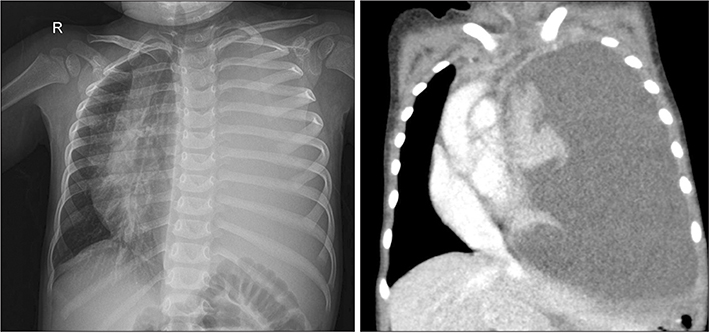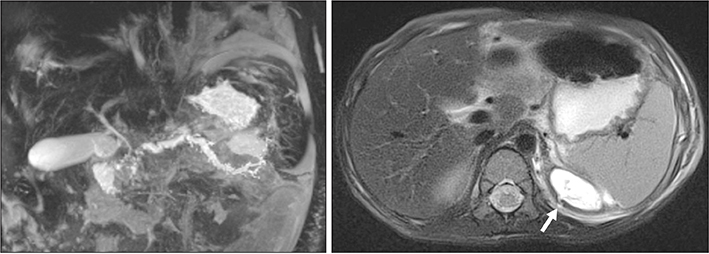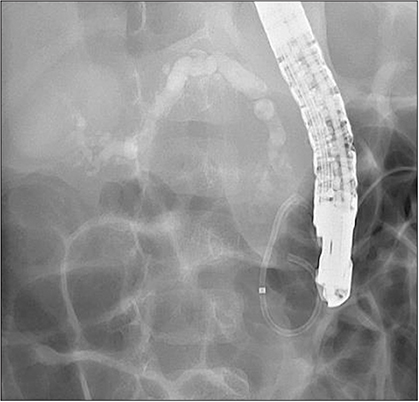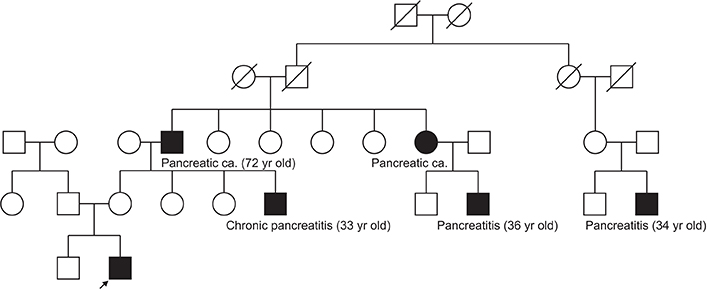Pediatr Gastroenterol Hepatol Nutr.
2019 Nov;22(6):601-607. 10.5223/pghn.2019.22.6.601.
Endoscopic Management of Pancreaticopleural Fistula in a Child with Hereditary Pancreatitis
- Affiliations
-
- 1Department of Pediatrics, Seoul National University College of Medicine, Seoul, Korea. kojs@snu.ac.kr
- 2Department of Internal Medicine, Seoul National University College of Medicine, Seoul, Korea.
- KMID: 2462102
- DOI: http://doi.org/10.5223/pghn.2019.22.6.601
Abstract
- Pancreaticopleural fistula (PPF) a fistulous connection between the pancreas and pleural space due to prolonged chronic pancreatitis (CP). PPF is a very rare complication which presents in 0.4% of chronic pancreatitis cases, especially among children. We report a case involving a 3-year-old boy who presented with pleural effusion caused by a PPF, a complication of hereditary pancreatitis, which was, for the first time in Korea, successfully managed with endoscopic treatment. Chest radiography and computed tomography showed massive pleural effusion. Percutaneous catheter drainage was performed. High amylase levels were observed in the pleural fluid and serum, suggesting PPF. The patient was managed with bowel rest and octreotide infusion. Endoscopic retrograde cholangiopancreatography revealed CP, and pleural effusion was successfully managed with stent placement. PRSS1 genetic screening revealed R122H mutation.
Keyword
MeSH Terms
Figure
Reference
-
1. Dhebri AR, Ferran N. Nonsurgical management of pancreaticopleural fistula. JOP. 2005; 6:152–161.2. Hastier P, Rouquier P, Buckley M, Simler JM, Dumas R, Delmont JP. Endoscopic treatment of wirsungo-cysto-pleural fistula. Eur J Gastroenterol Hepatol. 1998; 10:527–529.
Article3. Ranuh R, Ditchfield M, Clarnette T, Auldist A, Oliver MR. Surgical management of a pancreaticopleural fistula in a child with chronic pancreatitis. J Pediatr Surg. 2005; 40:1810–1812.
Article4. Altasan T, Aljehani Y, Almalki A, Algamdi S, Talag A, Alkattan K. Pancreaticopleural fistula: an overlooked entity. Asian Cardiovasc Thorac Ann. 2014; 22:98–101.
Article5. Rockey DC, Cello JP. Pancreaticopleural fistula. Report of 7 patients and review of the literature. Medicine (Baltimore). 1990; 69:332–344.
Article6. Xiao AY, Tan ML, Wu LM, Asrani VM, Windsor JA, Yadav D, et al. Global incidence and mortality of pancreatic diseases: a systematic review, meta-analysis, and meta-regression of population-based cohort studies. Lancet Gastroenterol Hepatol. 2016; 1:45–55.
Article7. Yadav D, Timmons L, Benson JT, Dierkhising RA, Chari ST. Incidence, prevalence, and survival of chronic pancreatitis: a population-based study. Am J Gastroenterol. 2011; 106:2192–2199.
Article8. Spanier B, Bruno MJ, Dijkgraaf MG. Incidence and mortality of acute and chronic pancreatitis in the Netherlands: a nationwide record-linked cohort study for the years 1995-2005. World J Gastroenterol. 2013; 19:3018–3026.
Article9. Vue PM, McFann K, Narkewicz MR. Genetic mutations in pediatric pancreatitis. Pancreas. 2016; 45:992–996.
Article10. Gariepy CE, Heyman MB, Lowe ME, Pohl JF, Werlin SL, Wilschanski M, et al. Causal evaluation of acute recurrent and chronic pancreatitis in children: consensus from the INSPPIRE group. J Pediatr Gastroenterol Nutr. 2017; 64:95–103.
Article11. Shin JY, Oh DS, Rheu JM, Shim JO, Park JS, Ko JS, et al. A case of hereditary pancreatitis with a N29I mutation in the cationic trypsinogen gene. Korean J Pediatr. 2006; 49:1111–1115.
Article12. Keim V, Bauer N, Teich N, Simon P, Lerch MM, Mössner J. Clinical characterization of patients with hereditary pancreatitis and mutations in the cationic trypsinogen gene. Am J Med. 2001; 111:622–626.
Article13. Howes N, Lerch MM, Greenhalf W, Stocken DD, Ellis I, Simon P, et al. European Registry of Hereditary Pancreatitis and Pancreatic Cancer (EUROPAC). Clinical and genetic characteristics of hereditary pancreatitis in Europe. Clin Gastroenterol Hepatol. 2004; 2:252–261.
Article14. Cazzo E, Apodaca-Rueda M, Gestic MA, Chaim FHM, Saito HPA, Utrini MP, et al. Management of pancreaticopleural fistulas secondary to chronic pancreatitis. Arq Bras Cir Dig. 2017; 30:225–228.
Article15. Francisco E, Mendes M, Vale S, Ferreira J. Pancreaticopleural fistula: an unusual complication of pancreatitis. BMJ Case Rep. 2015; 2015:bcr2014208814.
Article16. Ali T, Srinivasan N, Le V, Chimpiri AR, Tierney WM. Pancreaticopleural fistula. Pancreas. 2009; 38:e26–31.
Article17. Neher JR, Brady PG, Pinkas H, Ramos M. Pancreaticopleural fistula in chronic pancreatitis: resolution with endoscopic therapy. Gastrointest Endosc. 2000; 52:416–418.
Article18. Wronski M, Slodkowski M, Cebulski W, Moronczyk D, Krasnodebski IW. Optimizing management of pancreaticopleural fistulas. World J Gastroenterol. 2011; 17:4696–4703.
Article19. Wakefield S, Tutty B, Britton J. Pancreaticopleural fistula: a rare complication of chronic pancreatitis. Postgrad Med J. 1996; 72:115–116.
Article
- Full Text Links
- Actions
-
Cited
- CITED
-
- Close
- Share
- Similar articles
-
- Pancreaticopleural Fistula: CT Demonstration
- Pancreaticopleural Fistula Treated by Endoscopic Pancreatic Stenting in a Patient with Recurrent Pancreatitis
- Pancreaticopleural Fistula with Hemothorax
- Pancreaticopleural Fistula : Complication of Chronic Pancreatitis
- Successful Diagnosis and Treatment of a Pancreaticopleural Fistula in a Patient Presenting with Unusual Empyema and Hemoptysis





